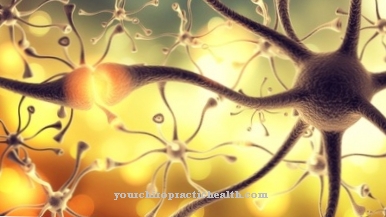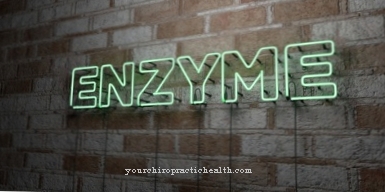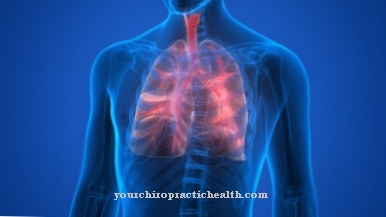The Conduction system of the heart consists of glycogen-rich specialized cardiac muscle cells. They bundle the contraction signals generated by the excitation system and pass them on to the muscles of the atria and the ventricles in a certain rhythm, so that an orderly sequence of systole (beat phase of the chambers) and diastole (relaxation phase of the chambers) is created, which for a continuous blood circulation to care.
What is the heart's conduction system?

The excitation conduction system of the heart is closely related to the excitation formation system, since it also consists of specialized myocardial cells and since parts of the excitation conduction system appear as stimulators in certain situations even in a backup process. The overall system, excitation formation and excitation conduction, is semi-autonomous. In principle it is autonomous, but it is also subject to the influence of the sympathetic and parasympathetic nervous system, so that the performance of the heart can be adapted to changing requirements via the beat frequency and blood pressure.
The semi-autonomous excitation formation and excitation conduction system can be controlled indirectly by external influences. At the same time, this means that the system can also be influenced and disrupted by certain neurotoxins via the sympathetic and parasympathetic nerves.
The heart's conduction system begins at the sinus node, the pacemaker in the right atrium, directly below the superior vena cava. The electrical impulse generated by the sinus node is distributed by the conduction system to the muscles of both atria so that they contract at the same time. The pulse is then picked up by the second pacemaker system, the [atrioventricular node]] (AV node) at the floor of the right atrium and delivered with a delay of about 150 milliseconds to the bundle of His, which is located in the septum between the atria and ventricles.
The bundle of His then divides into a left and two right chamber limbs, the tawara limbs. At their ends, the thighs branch further into the Purkinje fibers, which transmit the contraction impulse directly to the muscle cells of the ventricular muscles, so that the chambers contract at the same time.
The excitation conduction system works purely electrically via specialized cardiac muscle cells and not via nerves, so that the system works without special neurotransmitters.
Function & task
One of the two most important functions and tasks of the cardiac conduction system is the orderly transmission of electrical impulses first to the muscle cells of the atria and then to the ventricular muscles.
Normally, the electrical impulses are generated by the sinus node in the left atrium. In interaction with the excitation conduction system, the AV node and the bundle of His, the normal heart beat, which is also referred to as sinus rhythm, arises.Should the sinus node fail as a pacemaker or generate impulses that deviate significantly from the normal pattern, cells of the transmission system can generally generate electrical impulses themselves, which, however, are usually not ordered and can lead to a very disordered heartbeat sequence, especially in the atria.
The AV node can take on a real safety function as a secondary pacemaker. Its ordered basic frequency is 40 to 50 excitations per minute. The AV node takes over automatically when the impulses of the sinus node drop below the basic frequency of the AV node. If the AV node should also fail as a safeguard, the bundle of His, which is part of the conduction system, steps in as a tertiary pacemaker for the ventricular muscles with a frequency of 20 to 30 beats per minute. The process is also known as the chamber replacement rhythm.
The excitation formation and excitation conduction system enable the continuous flow of blood in the body's blood vessel system to be maintained and the rapid adaptation to changing requirements arising from different muscular activities and different sympathetic tone or stress modes.
The advantages of the semi-autonomous system developed by evolution are that the sequence of the heartbeat cannot be easily influenced by ingested food or toxins, but only indirectly via the sympathetic and parasympathetic nerve network.
Illnesses & ailments
The electrical impulse generated by the sinus node is passed on to the atrial muscles over a wide area via specialized myocardial cells before the impulses are picked up again by the AV node and passed on to the bundle of His with a delay.
Disturbances in the transmission of the contraction impulses occur frequently. They become noticeable through extrasystoles, an irregular heartbeat or an increased or decreased beat frequency as well as a changed beat rhythm. Symptoms range from harmless to severe and immediately life threatening.
Problems with the transmission of the stroke impulse within the atria occur relatively frequently. The excitations then run in a disorderly manner or move in a circular motion across the atria, which react with disorderly rapid muscle contractions. With this atrial fibrillation, beat frequencies of 350 to 600 Hz can occur, which, however, are filtered by the AV node and typically only "let through" at a frequency of 100 to 160 and passed on to the ventricular muscles. This results in a loss of atrial contractions, which is noticeably associated with a 15 to 20 percent loss of performance of the heart and can lead to a gradual overload of the ventricular muscles.
Also quite often - mostly temporary - cardiac arrhythmias are triggered by a so-called sinoatrial block (SA block). It arises from a delayed or interrupted transmission of the original sinus impulse to the muscles of the atria. It is therefore a question of a stimulus conduction problem even before the AV node is reached. An SA block can have many different causes and can also be triggered by a disturbance in the electrolyte composition or concentration. All types of conduction disorders in the atria are summarized under the term sick sinus syndrome.
A less common disorder of the stimulus transmission system is Wolff-Parkinson-White syndrome, which is a disordered circular excitation between the atria and the ventricles. It is caused by at least one additional pathway between the atria and ventricles, bypassing the AV node. Because the AV node is bypassed, the electrical impulses from the ventricles can also get back into the atria.




.jpg)






















